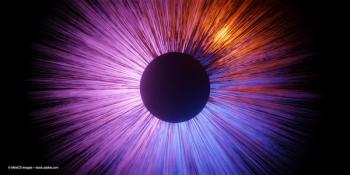
Genetic mutation findings in Spanish retinitis pigmentosa
New findings about a genetic mutation could lead to better clinical management and genetic counselling of families susceptible to retinitis pigmentosa, researchers said.
New findings about a genetic mutation could lead to better clinical management and genetic counselling of families susceptible to retinitis pigmentosa, researchers said.
Gly56Arg in the NR2E3 gene is a common mutation associated with autosomal-dominant retinitis pigmentosa, wrote Fiona Blanco-Kelly of the Genetics Department, Instituto de Investigación Sanitaria-Fundación Jimenez Diaz University Hospital, Madrid, Spain, and colleagues.
They found a prevalence of 3.5% for the mutation of the NR2E3 gene among 201 unrelated Spanish families. Night blindness was the first noticeable symptom, followed by visual field loss and loss of visual acuity.
More from this author:
They published their findings in
Retinitis pigmentosa is the most common form of inherited retinopathy, affecting 1 in 4000 people.
It is characterized by pigment deposits and progressive loss of photoreceptors, predominantly in the peripheral retina.
Recent:
Researchers have identified 69 genes that, when mutated, can cause retinitis pigmentosa, separate from other syndromes that may also cause the disorder.
Inheritance patterns may be autosomal dominant, autosomal recessive, X-linked, and maternal (mitochondrial), depending on the specific retinosa pigmentosa gene mutations present in the parental generation.
Related:
In Spain, the autosomal dominant form occurs in about 15% of families with retinitis pigmentosa, and 29 genes have been associated with it.
Among them is the NR2E3 gene, which contains eight exons that expand a genomic sequence of around 7.7 kilobases.
Most of the mutations in this gene have been associated with autosomal recessive retinitis pigmentosa, but the Gly56Arg in the first zinc-finger of the DNA binding domain has been found in autosomal dominant patients.
Related:
This mutation accounts for about 1-2% of North American and 3.4% of European autosomal dominant retinitis pigmentosa patients.
To learn more about this mutation in a population of 201 Spanish families with the autosomal dominant form of retinitis pigmentosa, Blanco-Kelly and her colleagues analyzed the families’ DNA.
They found that 7 out of 201 families had the Gly56Arg mutation. All these families were of Spanish origin, except for one with two grandparents from Venezuela.
Recent:
In two families, the researchers found a common haplotype as identified by four extragenic polymorphic markers. In another family, they found this haplotype as identified by three of the markers.
“These data support an ancient founder effect for the Gly56Arg in our families,” they wrote. They also cautioned that one family who did not come from the same small geographical area did not share the haplotype, a finding they called “unexpected.”
They speculated that the Gly56Arg mutation arose in ancient times, allowing time for multiple recombinations.
From these seven families, the researchers obtained clinical data for 24 subjects. In most cases, night blindness was the first noticeable symptom, with patients experiencing onset somewhere from their pre-adolescence to a few years after they were 20 years old. The mean age for this symptom was 15.9 (±10.1) years.
Recent:
Visual field loss was variable, but the patients tended to develop tunnel vision sometime soon after they were 30 years old. The mean age of onset was 23.2 (± 11.9) years. It stayed stable until an advanced age.
Loss of visual acuity tended to occur between the ages of 40 and 49. Two patients were legally blind (visual acuity less than 0.1 or visual field less than 10°) because of retinosa pigmentosa. One additional patient, who also had glaucoma, was diagnosed with complete blindness (neither perception nor projection of light) at the age of 53 years.
The researchers documented cataracts in 73.7% of the patients.
Ophthalmoscopic evaluation revealed fundus alternations that began with the visual impairments. Most of these were typical of retinitis pigmentosa. In addition, 47.7% of the patients had macular affectation, even when the patients were studied in the first stages of the disease.
Electroretinogram recordings, available in 19 patients, showed that alterations occurred at the beginnings of the disease. In those patients who were studied before they were10 years of age, the alterations appeared then as well.
Recent:
Fundus findings in some patients, such as macular changes and choriocapillaris atrophy, as well as eletoretinogram findings, such as impaired photopic and flicker records in the first stages of the disease, are not the classic changes described in European and North American patients with NR2E3 dominant forms of the disease.
These changes did not seem to correlate with visual acuity impairment, at least in the early stages of the disease, but this is not unusual in retinosis pigmentosa.
Editorial:
Since fundus changes have been observed in autosomal recessive patients, they could lead to a misdiagnosis if clinicians do not take into account family history, initial symptoms, and disease progression.
Clinicians can at least partially treat some of the changes, such as macular edema, making precise diagnosis and prognosis important, the researchers said.
Lessons from the playoffs:
The prevalence of 3.5% made this Gly56Arg mutation the second most common single mutation detected in this cohort of people with autosomal dominant retinitis pigmentosa.
Fiona Blanco-Kelly and her colleagues concluded that the findings can help clinicians use genetic analysis to determine who is at risk of retinosa pigmentosa, and how these patients can expect their disease to unfold.
Newsletter
Keep your retina practice on the forefront—subscribe for expert analysis and emerging trends in retinal disease management.














































